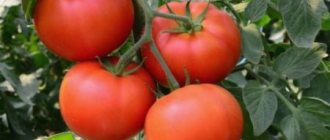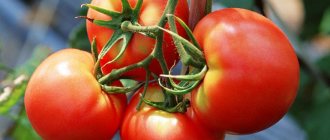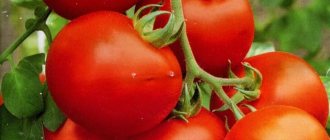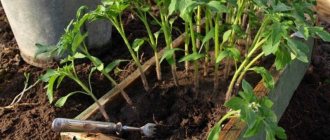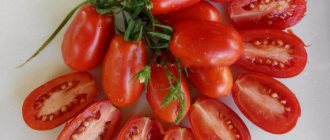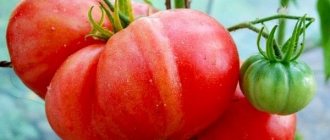The June tomato is winning the love of an increasing number of summer residents. It has good yields and does not require painstaking care like indeterminate varieties. Neat tomatoes of the same size can be used for a variety of purposes.
| Height | Landing location | Ripening time | Fruit color | Fruit size | Origin | Fruit shape |
| short | Greenhouse, Open ground | Early ripening | Reds | Average | Variety | Flat-round |
Advantages and disadvantages
Tomatoes of the June variety have a number of advantages, thanks to which they are chosen for planting:
- excellent taste of the fruit;
- the culture is universal in application;
- ease of care;
- stability of high yields;
- resistance to a large number of diseases characteristic of nightshade crops.
Experts and gardeners who grow June variety tomatoes say that they have only advantages in the complete absence of any disadvantages.
The best varieties of tomatoes for 2021: photos and descriptions
When choosing tomatoes for their plot, gardeners, first of all, rely on varietal or hybrid characteristics. Productivity is the most important criterion on which the quantity and quality of the harvest depends. Sometimes it can be difficult to choose the right option from the rich variety of tomatoes for open ground and greenhouses. Then varieties are selected depending on the growing region, ripening period, degree of disease resistance and other factors.
Varieties for open ground
A huge number of species with excellent yields are intended for growing vegetables in the open air. Low-growing bushes with large fruits are one of the advantages of tomatoes for the soil. Such heat-loving plants are easier to care for and do not require complex agricultural practices.
According to ripening period
Tomatoes, like other vegetable crops, are characterized by different ripening periods, from early to late.
| Ripening period | Ripening of fruits after the appearance of the first shoots | general characteristics | The most productive tomatoes (2020) |
| Ultra-early ripening | On day 80-85 | The fruits are small, juicy, and low in sugar. The height of the bush is no more than 50 cm. Not suitable for preservation. | Little Red Riding Hood, Pride of Russia, Benito, Superstar, Valentina, Marisha, Maksimka |
| Early ripening | For 90-95 days | Small, delicate fruits, average yield. Suitable for canning and salads. Bushes grow up to 70 cm | Agatha, Riddle, Augustine, Lyana, Sanka, Buyan, Lakomka, Amur standard, Grandmother's kiss |
| Mid-early | On days 100-103 | The fruits are juicy, small, aromatic. The purpose is universal. Bush shape - compact | Openwork, Babushkino, Pulka, Red Giant, Russian Soul, Cardinal, Flamingo |
| Mid-season | On day 100-115 | High taste, excellent yield. There are both low-growing and tall varieties | Scarlet Candles, Hybrid Basket, Stresa, Intuition, Black Baron, Pudovik, Pink Honey |
| Late ripening | On day 120-130 | Excellent fruit taste, high yield, universal purpose. Good keeping quality and transportability of fruits | Giraffe, Cosmonaut Volkov, Titan, Rio Grande, Russian size, King of Kings, Rocket, Premier |
The ripening time, color and shape of tomatoes depends on the variety.
Usually early-ripening vegetables with not large fruits and not a large harvest, but with a quick, friendly yield of ripe tomatoes. Mid-season ones also have medium sizes. Late ones are usually difficult to care for, but it is among them that you can find champions in weight, but there are not many such beauties on the bush.
By growing region
Every year, breeders create new species with high quality indicators. In stores you can buy specialized varieties of tomatoes designed for growing in certain climatic conditions. Classification by regions of Russia:
- for the Moscow region: Champion, Sweet Bunch, Honey, Pink Elephant, Fireworks, Bull's forehead;
- for the southern regions: Torch, Novice, Titan, Winner, Bison, Ermak, Gift, Mikado;
- for the middle zone: Bull's Heart, Black Prince, Uzbek (Yusupov), Moskvichka, Snowdrop, Big Brother, Spasskaya Tower;
- for Siberia: Siberian heavyweight, Ultra early ripening, Sanka, Abakan pink;
- for the Urals: Coin, Bull's Heart, Button, Countryman, Yellow Buyan, Bullfinch, Demidov;
- for the far north: Snowy Tale, Ballerina, Ladyfingers, Berdsky Large, Countryman, Oak, Gina.
Sowing seeds for seedlings
Before planting, it is recommended to check seeds for their germination. Having prepared a 5% salt solution, lower the seeds. Bad seeds will float on the surface of the water. They are collected using a spoon and thrown away, since they have lost their life-giving force. To grow stronger seedlings, it is recommended to harden the seeds for 2 weeks. The seeds are stored in warm conditions during the day and placed in the refrigerator at night.
Then it is necessary to carry out the procedure for disinfecting the seeds by treating them with a 5% solution of potassium permanganate. To consolidate the effect, experts recommend spraying the plants with a saturated decoction of onion peels after transplanting them to a permanent location.
It is recommended to soak the seeds in an immunocytophytic agent so that they are adapted to the effects of pathogenic microbes. Then the planting material must be soaked in Epin-Extra for 3-4 hours.
Important! The soil is also prepared in advance. Within 2-3 weeks before planting, it is necessary to bring the soil indoors at night and take it outside during the day. Before planting, a small amount of wood ash is added to the soil.
Growing rules
Like any tomato in our climate, the Blagovest variety is grown exclusively from seedlings. You won’t be able to get Blagovest tomato seeds yourself; you will have to buy them from the manufacturer. However, judging by the reviews of the Blagovest tomato, the seed has almost 100% germination.
There are no special differences in growing this variety from the classic method of cultivating tomatoes. Some of the nuances of growing relate to the method of forming the bush and the frequency of watering.
Planting seedlings
Tomato seedlings are planted according to the standard algorithm in early March. It is best to use individual containers in the form of peat pots. Soil for seedlings can be purchased, or you can make it yourself. Typically, a peat composition or its mixture with garden soil is used (50% each).
Two seeds are planted in each pot. Despite the very high germination rate of the hybrid, it is better to plant just this way, since it will not only guarantee germination, but also reject weak plants.
Under normal conditions, the seeds of the Blagovest tomato variety germinate on the 5th day after planting. As soon as this happens, the seedlings must be placed in a warm and well-lit place. The variety requires 10 to 12 hours of daylight, which means it is illuminated in the evening using fluorescent lamps.
1-2 weeks after germination, the weaker plant in each pot is pinched and the seedlings are fed with a special fertilizer.
Further care of the seedlings involves constantly keeping the soil moist, as well as regular ventilation of the room, lasting no more than 15 minutes.
Tomato transplant
Tomato variety Blagovest is transplanted 1.5 months after germination. Usually in greenhouses the plant is planted in rows with a distance between bushes of 30-50 cm.
Before planting, it is advisable to add a certain amount of organic fertilizer to the holes in the form of rotted manure, compost or peat.
Attention! Since the plant is transplanted into greenhouse conditions, it does not require pre-hardening. After transplantation, the soil around the young plants is compacted and they are watered with warm water in the amount of 10-15 liters per 1 sq.
m
After transplantation, the soil around the young plants is compacted, and they are watered with warm water in the amount of 10-15 liters per 1 square meter. m.
It is best to transplant in the evening or on a cloudy day.
Subsequent care for tomatoes
Subsequent care consists of timely watering of the plant, loosening and weeding the soil and applying 3-4 additional fertilizers during the season. To avoid constantly loosening the soil, you can mulch the soil over the entire area of the beds with hay or sawdust.
Watering in greenhouse conditions can have a frequency of 1 to 2 weeks, since, unlike growing in open ground, the soil remains wet for quite a long time.
Fertilizing is applied at intervals of 12-20 days, using superphosphate and potassium salts, alternating with organic matter, which is ideal for chicken manure diluted with water in a ratio of 1 to 10.
The main feature of subsequent care for Blagovest tomatoes is the correct formation of the bush. If a two-stem formation is used, it is necessary to use the stepson located under the third inflorescence.
In this case, it is recommended to transfer the growth point to it. This is done so that when tying the first cluster, the growth of the main stem does not stop. Although, in some cases, even after the first cluster is tied on the main stem, its growth does not stop. After the first brush is tied, all stepsons, except for the designated one, should be removed.
Important! Each of the stems requires obligatory garter to a support or trellis
Germination of seedlings
The prepared seeds are sown to a depth of 1 cm, then the soil is watered and covered with film. In order for the sprouts to hatch quickly, the room temperature must be between 23 and 25 degrees Celsius. When seedlings appear on the soil surface, the covering material must be removed. Next, the box with the seedlings in it is placed on the windowsill to provide a large amount of light.
After 4-5 true leaves appear on the bush, you should pick it, placing each plant in a separate container or glass. Before transplanting to a permanent location, it is recommended to harden off the seedlings. Initially, the plants should be in the fresh air for 5-10 minutes, then the period of time the bushes are outdoors gradually increases.
You may be interested in: Tomatoes and peppers in the same greenhouse: can they be planted, rules of the neighborhood? Is it possible to plant hot peppers next to cucumbers? Peppers and eggplants in the same greenhouse: can they be grown next to each other?
Mid-season productive varieties
For open ground
Volgogradsky. A productive variety with a mid-late ripening period. The bushes grow up to 80-115 cm in height. The fruits weigh on average 100-160 g. They are often grown on an industrial scale and have good shelf life and resistance to transportation.
Pink elephant is a mid-season variety with sweet and small tomatoes. Read more in the article: Pink Elephant tomato.
Giant 5 – Hybrid variety. Today this is the only hybrid that produces tomatoes weighing up to 1 kg.
Hybrid 35. An ordinary hybrid with red and round fruits that weigh on average 170-200 g. Flower clusters are tied every 3 leaves, many tomatoes are formed on them. This hybrid always produces a stable harvest of tasty and beautiful tomatoes. The variety is resistant to nightshade diseases and pest attacks, which is why it is valued by gardeners.
For greenhouses
Often, standard tomato varieties are cultivated in open ground. But in regions with a harsh climate, it is of course better to grow them in a greenhouse. At the same time, it is recommended to tie them to supports or a trellis, since the fruits may not ripen if the bush cannot support the weight.
Boni-M - Grows up to 25-35 cm in height, small ripe fruits appear on the bush 85 days after germination. It is grown exclusively by seedling method. Tomatoes have a sweet and pleasant taste. The fruits are flat-round, red in color, and weigh on average about 85 g.
Bushman - Bushes can be left without irrigation for a long time, without their productivity suffering. Plants grow up to 55 cm in height, they produce tomatoes weighing 110-130 g, and retain their taste and commercial qualities during transportation.
Denis - grows up to 35-55 cm. Despite the short stature of the bush, fruits weighing 250-300 g are formed on it. They do not crack and are pink in color.
Lion's Heart - the variety is resistant to late blight. The plant grows up to 65 cm in height. Ripe tomatoes are bright red in color with smooth and dense skin that does not crack, weighing about 200-300 g.
Secrets of transplantation and care
After normal weather conditions have been established and the ground has warmed up slightly, seedlings are planted in the ground. For planting, select lands on which the following crops have not previously grown:
- potato;
- pepper;
- tomatoes;
- physalis.
It is recommended to add manure and compost to the soil ahead of time. This helps provide nutrients to the crop throughout the season. To obtain an early harvest, it is recommended to transplant the bushes into the ground after the beginning of the flowering phase.
For 1 sq.m. Usually 6 to 7 bushes are placed. Fruiting begins after the formation of the root system is completed. To make this happen faster, the plants are regularly hilled and loosened between the rows. This measure will help provide the roots with sufficient oxygen.
Tomatoes of the June variety are watered 2-5 times during the week. In case of excessive heat, watering is carried out every day. Water should flow under the root, avoiding contact with the plant itself.
To increase the number of fruits, it is recommended to treat the bushes with stimulating drugs. This will help in the formation of ovaries. There is no need to tie up or plant tomatoes of the June variety. Sometimes it is possible to form bushes with 4 stems.
During the season, you do not need to add organic matter to the soil of the site, since the nutrient content in the soil is optimal for the growth of the variety.
Fruit characteristics
The plant produces neat multi-fruit clusters with 7-8 identical spherical tomatoes. June tomatoes do not have ribs and are distinguished by smooth skin with a uniform color.
The fruit shell is thick and strong. Tomatoes are not prone to cracking and rotting during the ripening period, so the yield of marketable products is quite high. Small-sized tomatoes (average weight - 100-130 g) are highly transportable and shelf-stable.
The pulp of the fruit has a dense and juicy consistency. The taste of fully ripened tomatoes is sweet and sour. The aroma is characteristic and well expressed.
Beautiful, medium-sized and calibrated tomatoes are perfect for whole-fruit canning. The preparations look impressive, especially in the form of assorted vegetables. Tasty and juicy fruits are also suitable for processing. The brightly colored pulp allows you to obtain the highest quality juices and sauces.
Due to the early ripening period, the June tomato variety is a desirable vegetable for fresh consumption. Dense tomatoes hold their shape well in salads or slices and are suitable for sandwiches and snacks. Thick walls and durable skin allow the fruits to be used for stuffing, raw or baked. The bright color of the pulp makes it possible to use June tomatoes for making sauces, soups or vegetable caviar.
Features of cultivation
Sowing of seeds is carried out 60 days before planting young plants in a permanent place. The optimal dates for the procedure are February and March. In the northern regions, sowing is allowed until mid-April.
Preparatory work with seeds is carried out if they were purchased secondhand. The material is treated with a solution of manganese and a growth stimulator.
To disinfect, simply immerse the seeds in the solution for 15-20 minutes, then dry on a napkin.
The container must be washed, provided with ventilation holes, and filled with soil. Make furrows in the soil up to 1.5 cm deep, keeping a distance of 1-2 cm between them. Place the seeds of the Mikado black tomato in the furrows, then sprinkle them with soil.
The tray with the crops should be covered with film and transferred to a warm room, on the windowsill. As soon as shoots appear, the shelter should be removed. Caring for seedlings involves watering and airing. Two weeks before transferring the seedlings to a permanent place, they need to be hardened off: taken outside for several hours.
Important! Shoots appear 7-10 days after sowing the seeds. As soon as the first two true leaves appear, the plants can be planted in separate containers: if you leave the tomatoes in one container, then the crop will not have enough space for full development
As soon as the first two true leaves appear, the plants can be planted in separate containers: if you leave the tomatoes in one container, then the crop will not have enough space for full development
The plant can be transferred to a permanent place 90 days after sowing: as soon as the first flower clusters are formed.
Mikado black tomatoes prefer fertile, light loamy or slightly acidic soils. You cannot place seedlings in the place of potatoes that grew last season. Safe predecessors are onions and carrots.
In the evening or cloudy weather, young tomatoes should be transferred to open ground or a greenhouse. The distance between bushes should be at least 50 cm. Place no more than 4 plants per 1 m2. The seedling must be placed in the hole, sprinkled with soil and watered. It is recommended to cover with planting material in the first few weeks to allow the Mikado black tomato to adapt and take root in the soil.
Important! The bed for Mikado black tomatoes should be in a well-lit place, but at high temperatures the tomato needs protection. Care Tips:
Care Tips:
- until the plant takes root, you need to water it as the soil dries out, and in the future it is recommended to moisten the soil up to 3 times a week;
- periodically mulch the ground around;
- form Mikado black tomatoes into 3 stems;
- regularly remove stepchildren;
- Apply mineral or organic fertilizers to the soil every 10-14 days.
Without organization of support, tomato stems will spread along the ground, the crop will die from excess moisture or attract the attention of pests. The best option is to build a trellis
The best option is to build a trellis
Wooden stakes, metal pins, and arcs can also be used as supporting structures. Additionally, it is recommended to tie the brushes so that the stems do not break off under their weight.
